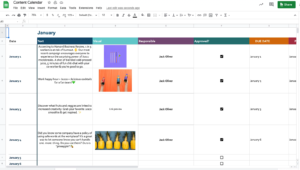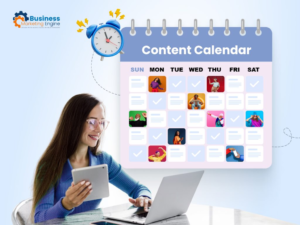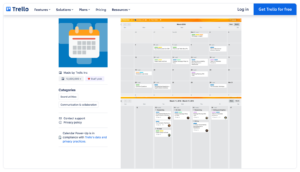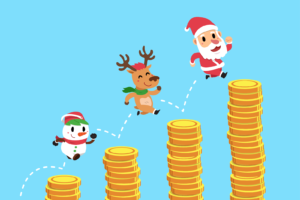Introduction
Marketing teams need a content calendar to stay organized and aligned in their efforts to engage and convert audiences. Using a structured calendar can streamline content creation, ensure timely distribution, and reach your audience across multiple platforms effectively.
You’ll learn how to create a content calendar, how to keep it dynamic and effective in this article. Additionally, a content calendar can help teams prioritize tasks and measure the success of their content. It can also help to identify any gaps in content, as well as areas of opportunity.
Content Calendar Overview

Content Calendars Made Easy Plan and Organize Your Marketing
A content calendar’s definition and purpose
Content calendars let you plan out what, when, and where of your marketing content. Marketers can plan their messages, campaigns, and posts with it, making it easy to produce, publish, and promote content.
Structured content planning is good for businesses of all sizes
In a competitive digital landscape, businesses need to plan their content to achieve consistency, increase productivity, and stay agile. Organizing their efforts will ensure content aligns with the brand’s message and goals, avoiding last-minute content decisions that could backfire.
Using a content calendar to align marketing with business goals
With a well-developed content calendar, you’ll ensure every piece of content contributes to your overall business goals. Clarity, efficient resource allocation, and a consistent message on all platforms are all benefits.
Calendar vs. marketing plan
What’s the difference between a marketing plan and a marketing strategy
A marketing plan outlines an organization’s overall marketing activities, but a marketing strategy details how you’ll reach your target audiences. Contrary to a content calendar, a content calendar specifies when, where, and what content will be posted. It’s part of the broader marketing plan, making strategy actionable.
A Content Calendar’s Place in a Broader Marketing Plan

Content Calendars Made Easy Plan and Organize Your Marketing
Each piece of content should align with your strategic goals, so your voice and message stay consistent. Content can be strategically deployed aligned with each campaign, ensuring every element contributes to your marketing strategy. Content should be tailored to your target audience, and optimized for search engines. Additionally, content should be regularly monitored and updated to ensure it is relevant and engaging with your audience.
Content Calendar Components
What You Need to Include
The types of content: blog posts, social media, emails, etc.
Find out what type of content works best for your audience – blog posts, social media updates, email newsletters, etc. It’s important to have a content calendar that covers different types of content to reach your audience.

Content Calendars Made Easy Plan and Organize Your Marketing
Image Courtesy –Business Marketing
The content is written, video, image, and interactive
Depending on the type of content, you can make articles, infographics, videos, or interactive quizzes. By aligning formats with audience preferences and platform capabilities, you’ll increase engagement and diversify your approach.
Each type of content needs its own audience segmentation and targeting
Content that’s tailored to specific segments in your audience is more relevant and engaging. Segment your content by demographics, interests, or buyer journey stages to make it more relevant to your audience.
Content Calendar Structure

Content Calendars Made Easy Plan and Organize Your Marketing
Data columns and rows for Date, Platform, Content Type, Keywords, and Objectives
Content calendars are usually tabular, with columns for dates, platforms, content types, keywords, and goals. You can see what’s upcoming and track the progress and purpose of each piece with this layout.
Use color coding, tags, and deadlines to simplify organization
Color-code your platforms and content types to make it easier to find what you’re looking for. Keep everything on track by setting deadlines for drafts and final approvals.
Measuring performance with metrics
Your content calendar should include metrics so you can track success and refine your approach. You can measure how well content meets its objectives by tracking engagement, conversions, and reach.
Plan your content calendar with these goals
Set clear goals
The common goals are brand awareness, engagement, lead generation, and conversions
It’s important that every piece of content has a purpose. Each piece should have a specific objective, such as building brand awareness, driving engagement, generating leads, or boosting conversions.
Matching content goals to business and marketing goals
You should make sure every content goal contributes to your business’s broader goals. Keeping marketing focused and delivering measurable results helps keep marketing on track. It also helps to ensure that resources are used efficiently, and that campaigns are effective. It also helps to create a culture of accountability and success.
SMART Content Marketing Goals
Setting Specific, Measurable, Achievable, Relevant, Time-bound Goals
You can make sure your goals are SMART by using SMART criteria. Set a SMART goal instead of “increase engagement”: “Increase Instagram engagement by 15% in three months.”

Content Calendars Made Easy Plan and Organize Your Marketing
Here are some examples of SMART content goals
SMART goals like “publish three blog posts per month to drive 20% more traffic by Q2” are great. If you apply such goals to your calendar, you’ll know how each piece fits into the bigger picture.
Using content audits to plan your calendar
Review existing content
Find out what’s missing from your content and what’s working.Get an idea of what your audience likes by reviewing past content. Identify high-performing pieces and content gaps to guide future creation.
Content Audit Tools (e.g., Google Analytics, SEMrush)
You can evaluate content performance, uncover gaps, and find audience preferences with tools like Google Analytics, SEMrush, or Ahrefs. These tools provide valuable insights into the performance of your content and can be used to optimize your content for better engagement. Additionally, they can be used to identify areas of your content that may need improvement.
Identify content needs and opportunities

Content Calendars Made Easy Plan and Organize Your Marketing
Repurpose or update existing content
Updating and repurposing successful content saves you time and gets you more bang for your buck. Turn popular blog posts into videos or infographics to keep people engaged.
Addressing Audience Questions or Needs
The content audit will help you identify frequently asked questions or unmet needs. Your brand will be more valuable to its audience if it creates content that addresses these issues.
Creating a content strategy that works
Topics and themes to focus on
Understanding Target Audience and Brand Voice to Define Core Themes. Consider your audience and your brand’s voice when establishing core themes. Make sure you talk about topics that align with your brand’s identity and address your audience’s key pain points.

Content Calendars Made Easy Plan and Organize Your Marketing
Topics around holidays, industry events, and brand milestones
Add relevant events or holidays to your calendar. You can make your content more timely and relevant by planning around these dates.
What kind of content to include
Choosing between evergreen and timely content
Content that’s evergreen stays relevant longer, while content that’s timely connects with current events. Your calendar stays fresh while staying relevant with a balanced mix.
Creating a variety of content: blog posts, infographics, videos, and case studies
Keep audiences engaged by experimenting with different content formats. You can accommodate different learning styles by mixing blogs, videos, case studies, and interactive content.
Integrated keyword and SEO

Content Calendars Made Easy Plan and Organize Your Marketing
Make a list of keywords that relate to your topic and audience
The importance of SEO in content planning can’t be overstated. Rank higher and attract more traffic with keyword research to align your content with search demand.
Adding keywords to your content calendar naturally
Make sure you include primary keywords in your calendar so creators remember SEO goals and keep the content flowing naturally.
Content Calendar Tools You Need

Content Calendars Made Easy Plan and Organize Your Marketing
Tools for content calendars
Here’s an overview of tools like Google Sheets, Trello, Asana, and Dedicated Calendar Software. Google Sheets, Trello, and Asana offer flexibility and features like tagging, deadlines, and collaborative access. You should evaluate options based on what your team needs.
User Experience, Cost, and Integrations Comparative Analysis
Compare tools based on things like cost, user experience, and integrations. Your workflow and budget should be aligned when choosing a tool. You should also consider the level of support available.Â

Content Calendars Made Easy Plan and Organize Your Marketing
Make sure the tool you choose offers adequate support to help you troubleshoot any issues. Finally, read reviews from other users to get a better understanding of the tool’s pros and cons.
Scheduling and automation
Scheduling content to reduce manual work
You can schedule posts automatically so they’re consistent without having to manually do it. Social media scheduling and tracking can be automated with tools like Buffer and Hootsuite.

Content Calendars Made Easy: Plan and Organize Your Marketing
Analytics, scheduling, and tracking tools
Track and report your content with tools like Sprout Social or HubSpot that integrate analytics. These tools help you measure the success of your content, identify trends, and optimize your campaigns. They also provide insights into how your audience is engaging with your content.
Content Creation and Approval Workflow
Setting up a pipeline for content creation
Giving tasks and deadlines to content creators, editors, and designers. Assign roles and set deadlines for each phase writing, designing, editing so the process goes smoothly.
Setting Quality and Consistency Guidelines
Make sure content aligns with brand values and has guidelines for tone, format, and quality. This will help to ensure content is consistent with your brand message and resonates with your target audience. Additionally, it can help to ensure that content is compliant with regulations and best practices.
Reviewing and Approving
Reviewing, editing, and final approval roles
Check content before publication, reduce errors, and ensure quality with a review process. Provide feedback to authors. Monitor the quality of the content. Ensure that the content meets all guidelines.

Content Calendars Made Easy Plan and Organize Your Marketing
Reviewing efficiently and on time
Streamline the approval process with clear guidelines for reviewers. They’ll be able to give feedback on time. This will reduce the risk of delays in production and ensure the quality of the finished product. It will also make it easier to identify any issues that need immediate attention.
The best time to publish your content
Optimising content schedules
Choosing the right frequency and timing for each platform. For each platform, there’s an optimal time to post content; align content with those times when audiences are at their most engaged. Monitor the performance of each post and adjust the frequency accordingly. Analyze engagement data to find the best time to post content for each platform. Experiment with different days and times to see what works best for your audience.
Scheduling around high engagement
Track engagement rates and experiment with different posting times to figure out when your audience is most active. Monitor analytics to see what works best for your brand. Adjust your posting schedule accordingly. Test different content types to see what resonates with your audience.
Refining scheduling with analytics
Enhancing timing by leveraging previous content performance
Optimize scheduling based on past analytics, paying attention to peak engagement times.

Content Calendars Made Easy Plan and Organize Your Marketing
These are some examples of metrics: engagement rates, peak viewing times, audience behavior
Improve future performance by using metrics like engagement rates, audience behavior, and peak viewing times.
Keep an eye on your content calendar and adapt it
How to measure content performance. KPIs are metrics that measure performance. Depending on the type of content and the goal. There are different KPIs for different types of content, like clicks, shares, and conversions. To make sure you’re assessing success accurately, define relevant KPIs.
Tracking metrics (Google Analytics, HubSpot, social media analytics)
You can track and measure content performance with tools like Google Analytics and HubSpot. Analyzing insights and adjusting
Analyzing data to inform future content
Your content strategy should be adjusted based on insights. Consider increasing the frequency of a specific format if it works.
Here are some examples of brands that adapted their calendars for better results
Better results come from brands that analyze and adjust based on performance data. A real-time response strategy helped Oreo stay relevant during events, for instance.
Fresh and relevant content calendar tips
Making flexibility a priority
Adding Flexibility to Your Calendar for Unexpected Events. Make room for spontaneous content to cover trends or unplanned events, boosting engagement.
How to create rapid-response content
Develop a flexible team and guidelines so you can respond to emerging topics or events with timely, relevant content.
How to keep your content engaging and dynamic
Utilizing user-generated content, customer stories, or employee spotlights. The more stories you include from your customers and employees, the more authentic it is.
Seasonal Content and Using Trending Topics or Industry News

Content Calendars Made Easy Plan and Organize Your Marketing
Your content will be more timely and relevant if you incorporate seasonal themes or trending topics.
Conclusion
A recap of how the content calendar plays a role in marketing success. Marketing without a content calendar is a waste of time. In addition to streamlining efforts, it keeps consistency, and links individual pieces together. I’m encouraging you to start small and scale up.Â
Make a simple calendar and add complexity as you go. Your calendar must be refined and adapted iteratively to be successful long-term. Your content calendar will be your marketing engine if you plan it right and keep it updated. Monitor your calendar regularly to make sure it’s working and adjust it as needed. Don’t be afraid to take risks and be innovative. Finally, stay focused on your goals.


